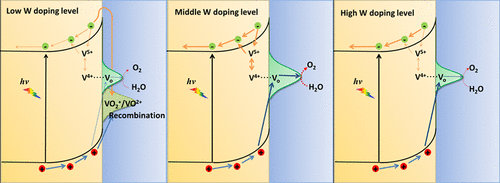当前位置:
X-MOL 学术
›
ACS Catal.
›
论文详情
Our official English website, www.x-mol.net, welcomes your feedback! (Note: you will need to create a separate account there.)
Role of Tungsten Doping on the Surface States in BiVO4 Photoanodes for Water Oxidation: Tuning the Electron Trapping Process
ACS Catalysis ( IF 12.9 ) Pub Date : 2018-03-09 00:00:00 , DOI: 10.1021/acscatal.7b04277 Qin Shi 1, 2 , Sebastián Murcia-López 2 , Pengyi Tang 2, 3 , Cristina Flox 2 , Joan R. Morante 2, 4 , Zhaoyong Bian 5 , Hui Wang 1 , Teresa Andreu 2
ACS Catalysis ( IF 12.9 ) Pub Date : 2018-03-09 00:00:00 , DOI: 10.1021/acscatal.7b04277 Qin Shi 1, 2 , Sebastián Murcia-López 2 , Pengyi Tang 2, 3 , Cristina Flox 2 , Joan R. Morante 2, 4 , Zhaoyong Bian 5 , Hui Wang 1 , Teresa Andreu 2
Affiliation

|
The nanostructured BiVO4 photoanodes were prepared by electrospinning and were further characterized by XRD, SEM, and XPS, confirming the bulk and surface modification of the electrodes attained by W addition. The role of surface states (SS) during water oxidation for the as-prepared photoanodes was investigated by using electrochemical, photoelectrochemical, and impedance spectroscopy measurements. An optimum 2% doping is observed in voltammetric measurements with the highest photocurrent density at 1.23 VRHE under back side illumination. It has been found that a high PEC performance requires an optimum ratio of density of surface states (NSS) with respect to the charge donor density (Nd), to give both good conductivity and enough surface reactive sites. The optimum doping (2%) shows the highest Nd and SS concentration, which leads to the high film conductivity and reactive sites. The reason for SS acting as reaction sites (i-SS) is suggested to be the reversible redox process of V5+/V4+ in semiconductor bulk to form water oxidation intermediates through the electron trapping process. Otherwise, the irreversible surface reductive reaction of VO2+ to VO2+ though the electron trapping process raises the surface recombination. W doping does have an effect on the surface properties of the BiVO4 electrode. It can tune the electron trapping process to obtain a high concentration of i-SS and less surface recombination. This work gives a further understanding for the enhancement of PEC performance caused by W doping in the field of charge transfer at the semiconductor/electrolyte interface.
中文翻译:

BiVO 4光阳极中用于水氧化的钨掺杂在表面态上的作用:调整电子俘获过程
纳米结构化的BiVO 4光电阳极通过静电纺丝制备,并通过XRD,SEM和XPS进行了进一步表征,证实了通过添加W可获得的电极的体积和表面改性。通过使用电化学,光电化学和阻抗光谱测量,研究了所制备的光阳极在水氧化过程中表面状态(SS)的作用。在伏安法测量中,在背面照明下,在1.23 V RHE处具有最高的光电流密度,观察到最佳的2%掺杂。已经发现,高PEC性能要求表面态密度(N SS)相对于电荷给体密度(N d)具有最佳比率。),以提供良好的导电性和足够的表面反应位。最佳掺杂(2%)显示出最高的N d和SS浓度,这导致了较高的薄膜电导率和反应位点。提示SS充当反应位点(i-SS)的原因是半导体本体中V 5+ / V 4+的可逆氧化还原过程,通过电子俘获过程形成水氧化中间体。否则,尽管电子俘获过程提高了表面复合性,但VO 2 +对VO 2+的不可逆表面还原反应。W掺杂确实会影响BiVO 4的表面性能电极。它可以调节电子俘获过程,以获得高浓度的i-SS和较少的表面重组。这项工作为在半导体/电解质界面处的电荷转移领域中由W掺杂引起的PEC性能增强提供了进一步的理解。
更新日期:2018-03-09
中文翻译:

BiVO 4光阳极中用于水氧化的钨掺杂在表面态上的作用:调整电子俘获过程
纳米结构化的BiVO 4光电阳极通过静电纺丝制备,并通过XRD,SEM和XPS进行了进一步表征,证实了通过添加W可获得的电极的体积和表面改性。通过使用电化学,光电化学和阻抗光谱测量,研究了所制备的光阳极在水氧化过程中表面状态(SS)的作用。在伏安法测量中,在背面照明下,在1.23 V RHE处具有最高的光电流密度,观察到最佳的2%掺杂。已经发现,高PEC性能要求表面态密度(N SS)相对于电荷给体密度(N d)具有最佳比率。),以提供良好的导电性和足够的表面反应位。最佳掺杂(2%)显示出最高的N d和SS浓度,这导致了较高的薄膜电导率和反应位点。提示SS充当反应位点(i-SS)的原因是半导体本体中V 5+ / V 4+的可逆氧化还原过程,通过电子俘获过程形成水氧化中间体。否则,尽管电子俘获过程提高了表面复合性,但VO 2 +对VO 2+的不可逆表面还原反应。W掺杂确实会影响BiVO 4的表面性能电极。它可以调节电子俘获过程,以获得高浓度的i-SS和较少的表面重组。这项工作为在半导体/电解质界面处的电荷转移领域中由W掺杂引起的PEC性能增强提供了进一步的理解。



























 京公网安备 11010802027423号
京公网安备 11010802027423号